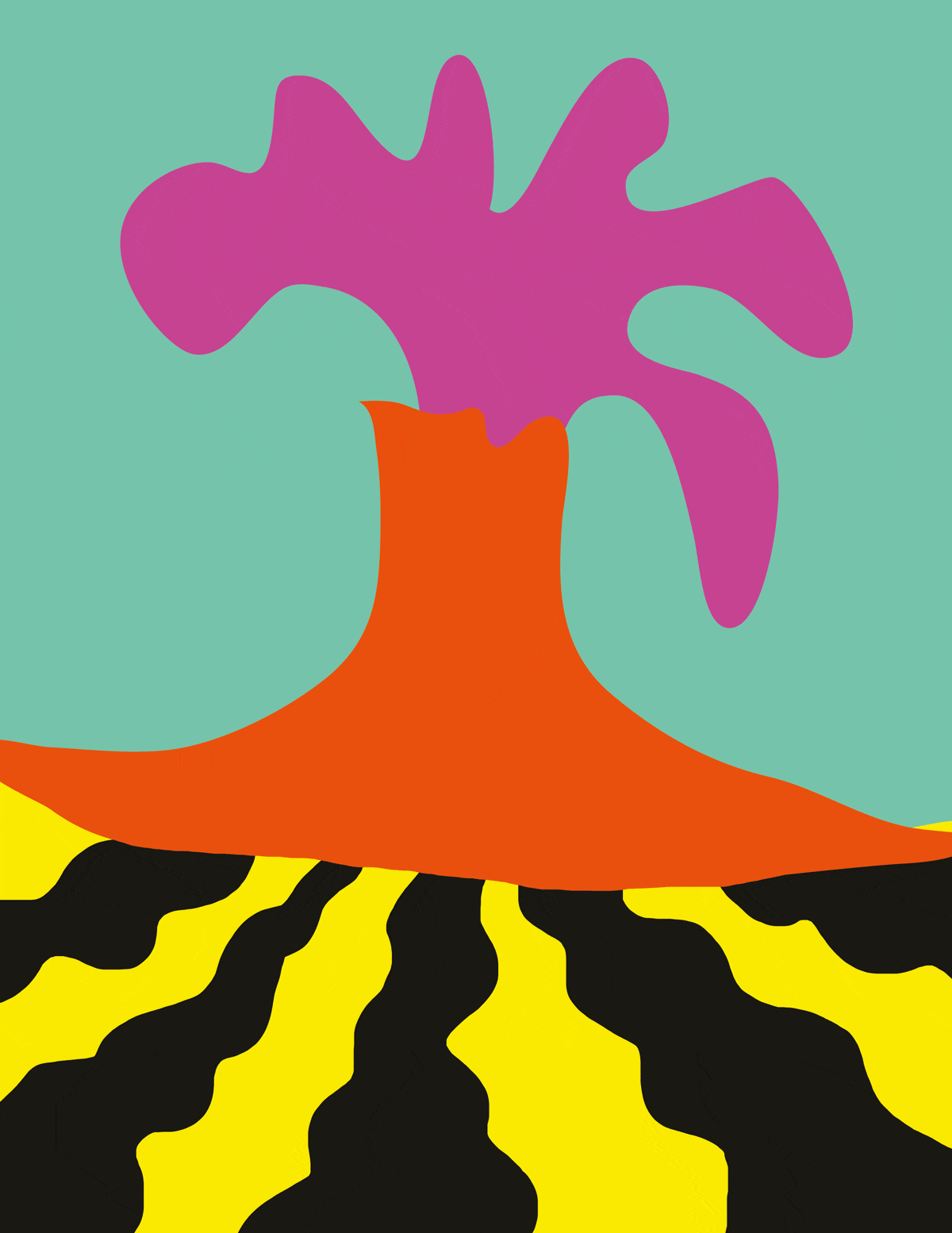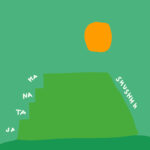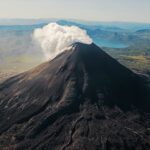I went to the volcano at dusk and watched a guard in a fluorescent vest move the orange safety cone every time the lava birthed forward. That is how lava moves when it’s slow: like a rolling molten birth.
The best time to go to the volcano is just as the sky turns dark, because the lava glows brilliantly then, almost neon, like the safety cone. All the tourists had read this in their guide books, and it was a big crowd. As the cone scooted forward, we scooted back to make room for nature.
My favorite part of this memory is how the guard, a heavyset Hawaiian man, was so bored by his volcano. He was eating a bag of Maui onion chips and every minute or so, to entertain himself and us, he’d toss one at the lava. The crowd ooh’d and aah’d when it burst into a tiny potato fire.
In a way, this tiny potato fire was kind of everything, the culmination of a circle. The lava made the island. The island made the potatoes. The Hawaiian Chip Company made the chips, which would have been a simple form of nourishment if they weren’t also sort of a destructive force on the heavyset guard, and which he then chose to destroy for pure entertainment. In this last statement, nature’s circle is disturbed by human tampering, and really, it seems only natural. We are imperfect beings in a perfect world.
Quod me nutrit, me destruit. This Latin phrase, first found on a portrait of the playwright Christopher Marlowe and now considered camp thanks to an Angelina Jolie tattoo, is an apt description of the element of fire. Fire is nourishment. Fire is destruction. Fire is life. Fire is death. Fire is enlightenment. Fire is suffering. Fire is warming, consuming, illuminating, horrifying. The element of fire is defined by its duality. It’s at war with itself. It’s fraught; it has a churning quality. Stare at a flame and watch how it morphs. It’s always transforming. How it transforms us depends on how we use it.
Throughout history, across cultures and time, fire has been symbolized and mythologized in a great number of ways, and many of them are strikingly similar. We use the word flickering to describe the essence of fire, we say flames lick. We also say they dance. In paintings, flames are often depicted as flailing tongues, haphazard brushstrokes of red, yellow and orange. Artistic attempts at capturing the ineffable quality of fire are never not clumsy.
In the body, the fire chakra sits around the navel, right at the solar plexus. It’s the third one up and it’s most often depicted as yellow. Called Manipura, which in Sanskrit means “lustrous gem”, this is the chakra responsible for our digestion both of food and of emotions. It’s associated with energy and anger. It’s our transformative center, both anatomically and in a deeper, more spiritual sense. By meditating on Manipura, we hone our power.
Pele, like all symbols of fire, works in opposing ways. Pele loves us. She creates the land. Pele hates us. She destroys what we built. Pele is an angry force, and also a protective one. A well-known bit of Hawaiian lore is that if you take anything off Pele’s islands – lava, rocks, sand – you will be cursed.
Power is the dominant characteristic of the fire element in the astrological world. People with Aries, Leo, and Sagittarius signs embody strength, independence, passion, and action. They’re the people most likely to take risks.
In many cultures (Christian, Hebrew and Chinese), fire represents divinity. In Egypt, it symbolizes a sense of superiority. In Theravada Buddhism, it’s regarded as dangerous. The Buddha’s third teaching, called The Fire Sermon (after which T.S. Eliot’s third section of The Waste Land is named), describes thoughts as “burning” with four types of fire – the fire of passion, of aversion, of delusion, and of suffering – and suggests that the path to freedom from these fires is to become disenchanted.
Enchanting is another word we often use to describe fire. We might associate it with romance.
So did Freud, who thought fire represented secret passions. Dreams about fire are said to represent desire, as well destruction and purification, which is exactly what a forest fire is: old matter burning away to make room for a new system.
Our ancestors first experienced fire as a thing that wanted to destroy them. Can you imagine what it must have been like to have no understanding of fire, and then to see it engulfing a field? I would have thought it was God too, or some other non-human force. Without a logical explanation for what they saw, our ancestors created stories.
In Greek mythology, Prometheus retaliated against the gods by stealing fire and giving it to humans. In Nigerian Ekoi mythology, a young boy stole fire from a god for humanity. In Norse mythology, Loki learns the secret of fire from an eagle. The theme of fire as stolen – most often from a deity or an animal deity – and then offered to civilization is a recurring one and that makes sense, since we didn’t invent fire. Rather, we learned how to strike it up in small batches. Unlike the other elements, fire is the only one that humans can make themselves, and this must have been confusing in the beginning. Who controlled fire? Was it us? Was it the gods? Or was it both? These are the questions that myths about fire are trying to reconcile.
In Hawaiian mythology, Pele is the goddess of fire and of creation. She made the Hawaiian islands and rules the volcanoes, including the one mentioned above, Kilauea, which is notable because it’s been active since 1981 and still is. She who shapes the sacred land also wreaks havoc on it, like when, for example, the lava flows in an inconvenient direction, over expensive new highways and into towns. When nature threatens our man made domains, we contain it – or at least we try to. Sometimes we fail and it ruins what we built. In 2018, a massive lava flow off Kilauea destroyed 700 buildings and re-shaped the southern coastline.
Pele, like all symbols of fire, works in opposing ways. Pele loves us. She creates the land. Pele hates us. She destroys what we built. Pele is an angry force, and also a protective one. A well-known bit of Hawaiian lore is that if you take anything off Pele’s islands – lava, rocks, sand – you will be cursed. Many locals understand Pele’s anger to be karmically warranted. We trash her rainforests with plastic bottles and pollute her seas with cruise ships; of course she’s pissed off. Among the native Hawaiians I’ve met, there’s a kind of “we deserve it” vibe.
In modern terms, the layers of Pele’s nurturing take on new meaning. Hawaii’s largest form of income is tourism. Many people come to the Big Island to see the volcano. Hawaii needs these tourists to thrive.
The layers of Pele’s damages expand more subtly in the other direction as well. Volcanic fog, known as vog, which is sometimes so thick it covers the island like a gray blanket, can be extremely harmful, especially to people with respiratory issues. Many mainlanders who move to Hawaii leave for this reason.
The relationship between humans and the element of fire is playing out continuously on Hawaii’s Big Island as the lava continues to flow. It’s a double-edged dance, and a charged one, and this is what we mean when we describe something as fiery or hot: that it’s full of energy, sometimes unpredictable, and potentially transformative – for better or for worse.
As the crowd ooh’d and aah’d at the volcano guard’s potato chip fire, I remember staying silent. I also remember how badly my head hurt, and how hard it was just to stand there. I’d been drinking the night before, and heavily, as usual. Earlier I used the guard’s chips as an example of self-sabotage via fire, both the eating of them and the flagrant burning. This is another example.
Humans feared fire less after they learned how to contain it. Homo erectus, as we were known back then, is said to have controlled fire as far back as 1.7 million years ago. The story of how we came to use fire for our benefit has the same flavor as the story of how we invented tea when a leaf fell into a cup of hot water. Just as often as necessity is the mother of invention, so it seems, are accidents. We assume that post-wildfire, an early being found a bit of charred meat and grunted, oh.
My epiphany about how alcohol was destroying my life wasn’t this clear cut and it might not have had anything to do with Kilauea, but weirdly it was just after this visit that I stopped drinking. Alcohol, of course, works in the same way fire does. When contained in small batches, it’s a great thing. But when it gets out of control, it’s like a wildfire, or like a volcano, erupting.
If you go to the Big Island now, you can see that above where the lava births into the ocean, there is a plume of smoke, always rising. And you can imagine how below that, under the water, the earth is reshaping itself, ruining the old outline to become something new. A reminder that as we transform, so, too, is everything around us transforming.
Swan Huntley is the author of The Goddesses (2017) and We Could Be Beautiful (2016). She lives in Los Angeles and New York.






